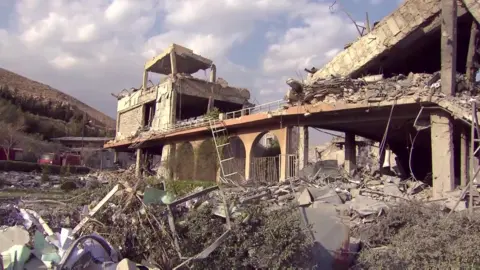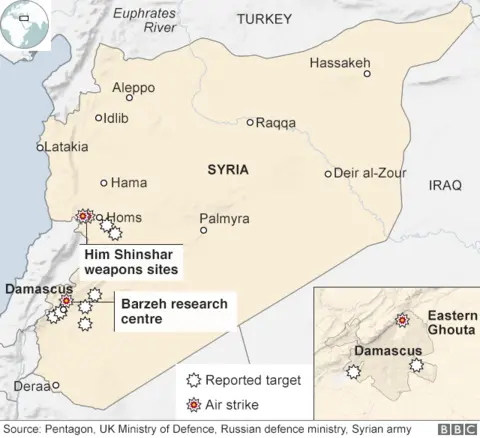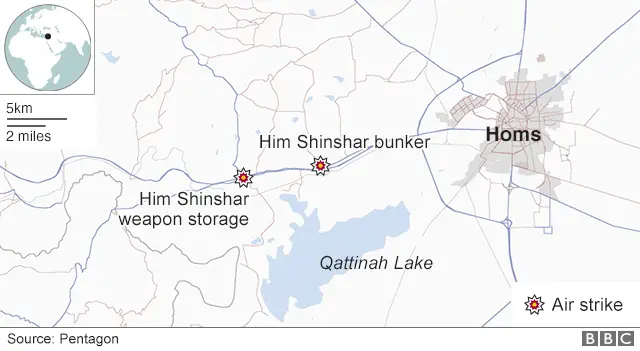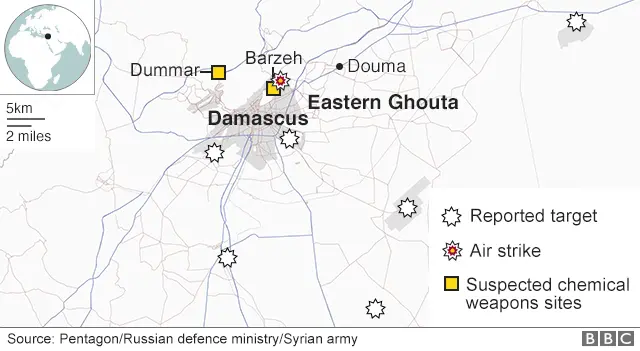US-led strikes on Syria: What was hit?
 CBS
CBSThe US, UK and France say their air forces and navies fired 105 missiles, targeting three key sites in Syria.
US Defence Secretary Jim Mattis said the allies had taken "decisive action" against the Syrian government's "chemical weapons infrastructure".
The strikes took place at about 04:00 local time (01:00 GMT) on 14 April, a week after a suspected chemical attack on the then-rebel-held town of Douma, which opposition activists, medics and rescue workers say killed more than 40 people.
President Bashar al-Assad's government has denied ever using chemical weapons, and its key ally Russia says it has evidence the Douma incident was "staged".

The Syrian government insists its entire chemical arsenal was destroyed under a deal signed after an attack in 2013 that involved the nerve agent Sarin.
However, experts from the UN and the Organisation for the Prohibition of Chemical Weapons (OPCW) have ascribed four chemical attacks to the government since then, including a 2017 Sarin attack on rebel-held Khan Sheikhoun.

What was targeted?
The chairman of the US Joint Chiefs of Staff, General Joseph Dunford, said the missiles had hit and destroyed three targets "specifically associated with the Syrian regime's chemical weapons programme".
Barzeh scientific research centre


The branch of the Scientific Studies and Research Centre (SSRC) in the capital's northern Barzeh district was a "centre for the research, development, production and testing of chemical and biological warfare technology", Gen Dunford said.
Lt Gen Kenneth McKenzie, director of the US military's Joint Staff, said the US fired 76 missiles at the facility - 57 Tomahawk cruise missiles and 19 joint air-to-surface stand-off missiles.
"Initial assessments are that this target was destroyed. This is going to set the Syrian chemical weapons programme back for years," he said.
A man identified by CBS News as a scientist who worked there for 38 years said it was "totally incorrect" that chemical weapons were being developed at the site.
The Syrian state news agency reported that several missiles hit the SSRC facility, "destroying a building that included scientific laboratories and a training centre".
The SSRC is a government agency that is officially tasked with advancing and co-ordinating scientific activities in Syria.
However, a Western intelligence agency told the BBC in May 2017 that the SSRC branch in Barzeh - along with two others in nearby Dummar (Jamraya) and in Masyaf, in Hama province - were being used to produce chemical and biological munitions in violation of the Chemical Weapons Convention (CWC).
Despite the allegations, the OPCW subsequently reported that it had carried out two inspections of Barzeh and Dummar facilities - which is also known as Jamraya - in February and November 2017 and not observed "any activities inconsistent with obligations under the CWC".
Him Shinshar chemical weapons storage site, west of Homs

Gen Dunford said the US believed the Him Shinshar chemical weapons storage site was "the primary location of Syrian Sarin and precursor production equipment".
Gen McKenzie said 24 missiles hit the facility - nine US Tomahawk missiles, eight British Storm Shadow missiles, and 5 naval cruise missiles and 2 SCALP cruise missiles launched by France.


The UK Ministry of Defence said Royal Air Force Tornado GR4s had launched eight Storm Shadow missiles at a military facility in the same location - a former missile base some 25km (15 miles) west of the city of Homs.
The facility was used to "keep chemical weapon precursors stockpiled in breach of Syria's obligations under the Chemical Weapons Convention". Precursor chemicals are generally dual-use chemicals that can be combined to produce blister agents like sulphur mustard or nerve agents like Sarin.
"Very careful scientific analysis was applied to determine where best to target the Storm Shadows to maximise the destruction of the stockpiled chemicals and to minimise any risks of contamination to the surrounding area," the MoD added.
Syria's state news agency reported that missiles had targeted a military position in Homs province, but that they had been "thwarted and diverted from their path". Three civilians were injured, it said, without providing any further details.
Him Shinshar chemical weapons bunker

Gen Dunford said the facility, about 7km from the storage site, "contained both a chemical weapons equipment storage facility and an important command post".
Gen McKenzie said seven French SCALP missiles were deployed and that the bunker facility was "successfully hit".

Were any missiles intercepted?
Gen McKenzie said initial indications were that the objectives were "accomplished without material interference from Syria".
"We are confident that all of our missiles reached their targets. At the end of the strike mission, all of our aircraft safely returned to their bases."
The general said the US military assessed that more than 40 surface-to-air missiles were launched by Syrian government forces.
"Most of these launches occurred after the last impact of our strike was over," he noted, adding that it was likely most of the missiles were fired without guidance.
Although he was confident the strikes "took the heart out of" the Syrian government's alleged chemical weapons capability, Gen McKenzie said he could not rule out that such weapons might be used again.
"There's still a residual element of the Syrian programme that's out there," he said.
"I'm not going to say that they're going to be unable to continue to conduct a chemical attack in the future. I suspect, however, they'll think long and hard about it."

What does Russia say?
Russian military spokesman Colonel-General Sergei Rudskoi told reporters in Moscow that "a number of Syrian military airfields, industrial and research facilities" were targeted by US, British and French missile strikes.

Syria's mostly Soviet-era air defence systems had "successfully countered the air and naval strikes", intercepting 71 of the cruise missiles, Gen Rudskoi added.
He cited Russian military data as showing:
- Four missiles targeted Damascus International Airport
- 12 targeted the Dumayr airbase, east of Damascus, but all were shot down
- 18 targeted the Marj Ruhayil (Bulay) airbase, south of the capital
- 12 targeted the Shayrat airbase, but all were shot down
- Five out of the nine that targeted the Mezzeh military airport were shot down
- Thirteen of the 16 that targeted "Homs aerodrome" were shot down
- Thirty targeted facilities related to Syria's alleged chemical weapons programme in Barzeh and Jaramana, a south-eastern district of Damascus. Seven missiles were shot down. The facilities were partially destroyed, but had not been used for a long time, according to Gen Rudskoi
"Russia considers the strike to be a response to the success of the Syrian armed forces in fighting international terrorism and liberating its territory, rather than a response to the alleged chemical attack," Gen Rudskoi said.
